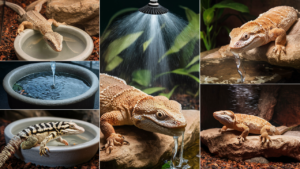Caring for pets like reptiles, fish, parrots, and turtles involves understanding their specific needs for a healthy and happy life. This article delves into the best substrate choices for reptiles, the optimal feeding frequency for fish, exercise routines for parrots, and how to maintain proper water quality for turtles, ensuring their well-being and longevity.
Understanding Reptile Substrates
Selecting the right substrate is crucial for reptile health. Soil, bark, and sand impact humidity and psychological well-being. For rainforest species, use moisture-retaining substrates like coconut fiber, promoting both humidity and comfort. In contrast, desert reptiles thrive on hot, dry sands, allowing for essential burrowing behaviors. Choose substrates that mimic natural habitats to enhance your pet’s quality of life and reduce stress. Always consider the specific climatic requirements of each reptile species when making substrate decisions. Proper substrate impacts not just their physical health, but also their behavioral responses in captivity.
Types of Reptile Substrates
Choosing the right substrate significantly impacts reptile health. Options like coconut fiber, aspen shavings, and bioactive substrates each have distinct benefits.
Coconut fiber retains moisture, fostering humidity, ideal for tropical species like chameleons, while also being biodegradable. Conversely, it can harbor mold if overly damp.
Aspen shavings offer a cleaner, longer-lasting alternative, great for species that require dry habitats, such as desert-dwelling lizards. However, they can cause respiratory issues if dust is inhaled.
Bioactive substrates cultivate beneficial bacteria and microorganisms, promoting a self-sustaining ecosystem for species like dart frogs. Yet, they require careful management to maintain balance and prevent pests.
When selecting a substrate, consider not just the species’ habitat requirements, but also aesthetic elements that enhance the display. A well-chosen substrate not only meets functional needs but also contributes to the visual appeal of your pet’s environment.
Optimizing Fish Feeding Frequency
Feeding frequency is crucial for fish health, with variations based on age, size, and species. Adult fish typically require feeding once or twice daily, while younger fish may need three to five smaller meals. Species-specific needs differ; bottom feeders like catfish often scavenge and can go longer between feedings compared to mid-water swimmers such as tetras. Overfeeding can lead to bloating and water quality issues, while signs of malnutrition include lethargy and poor coloration. Adjusting portions and frequency to match the fish’s active hours and behaviors is essential for maintaining optimal health.
Best Practices for Feeding Fish
For optimal fish health, consider diverse diets tailored to species needs. Use **high-quality pellets** or **flakes** as staple foods, ensuring proper portion sizes without overfeeding. Incorporate **live food** like brine shrimp or daphnia for essential nutrients, particularly for young or breeding fish. Adjust feeding frequency based on activity levels and the fish’s age, monitoring for signs of hunger or distress. Aim for a **balanced diet** that supports growth, coloration, and overall wellness. Ensure water quality remains stable after feeding to prevent excess waste and ammonia buildup.
Creating an Exercise Routine for Parrots
Exercise is vital for parrots’ physical and mental health. Incorporating daily activity can prevent obesity, boredom, and behavioral issues. Strategies include:
– **Free flight:** Allow supervised, safe flight time in a bird-proofed area to develop muscles and confidence.
– **Playtime:** Engage with toys and climbing structures to encourage exploration and natural behaviors.
– **Mental stimulation:** Rotate toys regularly and introduce challenging puzzles to keep their minds active.
Balancing structured activities with opportunities for free exploration fosters overall well-being, ensuring your parrot remains healthy and happy.
Environmental Enrichment for Parrots
Creating a stimulating environment for parrots is vital for their mental and emotional well-being. Engaging their natural instincts through **bold climbing structures** and **intriguing toys** encourages exploration and interaction. Incorporating **social interactions** helps build strong bonds, reducing boredom-induced behavioral issues. Regularly rotating toys keeps the environment fresh, while appropriate climbing surfaces promote physical activity and agility as they thrive on mental challenges.
Importance of Water Quality for Turtles
Water quality is essential for turtle health, impacting their immune systems and organ functions. **Key parameters** like pH, typically between 6.5-7.5, directly influence their comfort and stress levels. **Temperature**, ideally maintained between 75-85°F, ensures metabolism functions efficiently. **Effective filtration systems** remove waste, promote beneficial bacteria, and reduce harmful toxins. To maintain clean water, regularly test parameters and replace 10-20% weekly. Incorporate plants for added filtration and shade. Regularly observe turtles for signs of distress; cloudy water or foul odors indicate issues needing immediate attention. These practices ensure a thriving habitat, paralleling the enriched environments intended for parrots, aiding overall well-being.
Maintaining Optimal Water Conditions
Maintaining optimal water conditions is essential for turtle health and longevity. Regular testing using pH strips or electronic meters helps monitor critical parameters. Weekly water changes of 25-50% remove toxins and replenish essential minerals, keeping turtles active and vibrant. An effective filtration system, like canister or power filters, significantly reduces harmful bacteria and waste buildup, ensuring cleaner environments.
Common water quality issues include cloudy water, foul odors, and algae growth. If water becomes murky, check the filter for clogs or the need for replacement. Increasing the frequency of water changes can also help. For foul odors, performing partial water changes and cleaning the substrate often resolves the issue. Algae blooms can be managed through controlled light exposure and adding aquatic plants to consume excess nutrients.
Monitor temperature regularly with thermometers, adjusting heaters as necessary to keep the water within the preferred range of 75-80°F. Ideal pH levels should fall between 6.5 and 7.5, as imbalances may adversely affect turtles. Alkalinity and hardness are also important; test kits are available to ensure these parameters stay stable.
Finally, introducing beneficial bacteria can help create a balanced ecosystem in the turtle tank, further promoting healthy water conditions. Always observe the turtles’ behavior; sluggishness or erratic swimming can signal water quality issues requiring prompt attention.
Conclusions
In summary, providing appropriate substrates for reptiles, managing feeding frequencies for fish, facilitating exercise for parrots, and maintaining high water quality for turtles are fundamental to their care. Each aspect contributes significantly to their health, happiness, and longevity, emphasizing the importance of attentive pet ownership.



